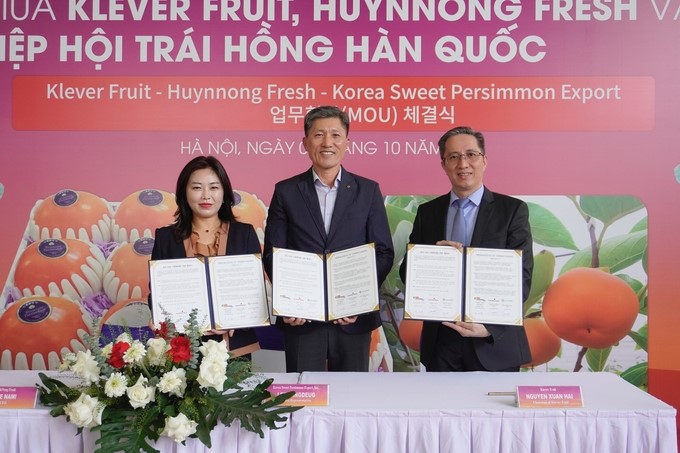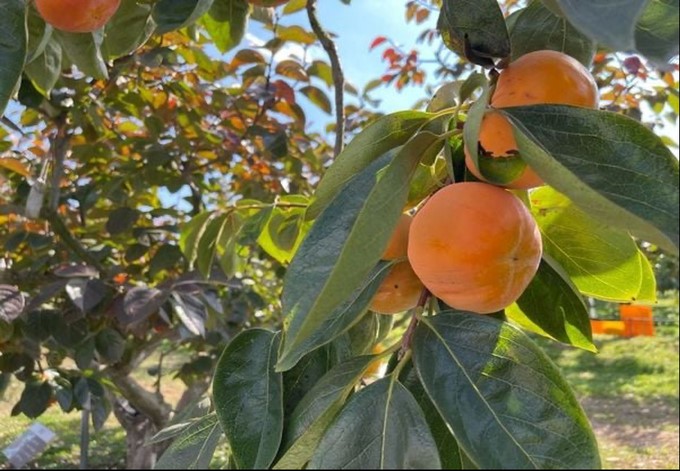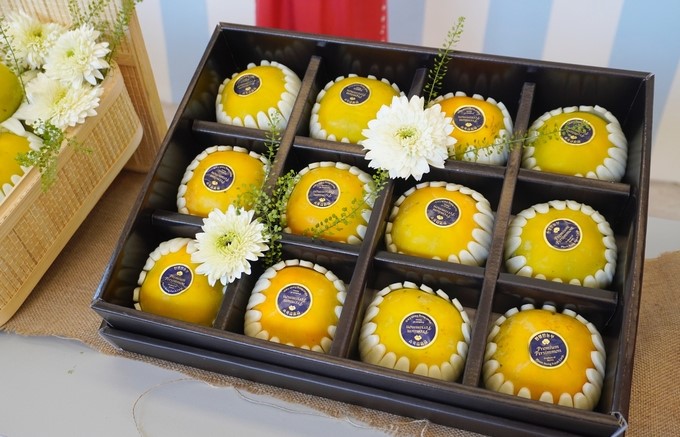November 28, 2025 | 03:44 GMT +7
November 28, 2025 | 03:44 GMT +7
Hotline: 0913.378.918
November 28, 2025 | 03:44 GMT +7
Hotline: 0913.378.918
On the afternoon of October 7, in Hanoi, Klever Fruit, a unit specializing in importing high-end fruits from countries around the world; HuynNong Fresh, a high-end gardener in the Republic of Korea; and the Korea Sweet Persimmon Export Association, an organization representing the Republic of Korea's persimmon industry, signed a Memorandum of Understanding (MOU) to promote the promotion of Korean persimmons to Vietnam.
Mr. Nguyen Xuan Hai, General Director of Klever Fruit, shared that this event is an important milestone in the strategic cooperation relationship to develop high-end agricultural products between the two countries in general and between Klever Fruit and its partners in particular.

MOU signing ceremony between Klever Fruit, HuynNong Fresh, and the Korea Sweet Persimmon Export Association to promote the promotion of Korean persimmons to Vietnam. Photo: Hong Tham.
Mr. Lee Sangdeug, representative of the Korea Sweet Persimmon Export Association, said that Korean persimmons were first exported to Southeast Asian markets since 1995, then expanded to other markets. Currently, Korean persimmons are widely present in many markets in Southeast Asia, in addition to Hong Kong, Canada, Saudi Arabia, and Dubai.
The Korea Sweet Persimmon Export Association has developed a specific guide for members so that persimmon growing meets the standards of each region and country in the world. Gardeners and farm owners strictly follow these instructions, from choosing persimmon varieties, planting persimmons, caring for them, preserving them, harvesting, and selecting each persimmon that meets export standards.
Mr. Kim was formerly a high school math teacher, but now he is a persimmon farmer and the owner of a leading high-quality persimmon packing factory in Gyeongsangnam-do province, which is the capital of Korean persimmons. He shared: "I am a scientist, so I strictly follow the recommendations of the professor from the Korea Sweet Persimmon Research Institute and also maintain this very strictly. Therefore, the quality and output of my persimmons this year still maintain the top position in the region.
The point I want to talk about most is the issue of using pesticides and chemical residues. We are very careful and take this issue seriously so that persimmons meet the highest standards of the Republic of Korea. The final stage is preservation and packaging. My team and I also thoroughly check each box before loading it onto the truck."
"Actually, it is not always successful, but I always persevere and keep my love for the persimmon tree, and so far this love of nearly 20 years has been repaid," Mr. Kim confided.

Each light scratch is the mark that Mother Nature has confirmed for each persimmon about its maturity. Photo: KL.
Representative of the Korea Sweet Persimmon Export Association Lee Sangdeug said: "When mentioning Vietnam, people in the Republic of Korea will immediately think of tropical fruits such as mango, pineapple, etc. Accordingly, Vietnam can focus on these strong fruits for export to the Republic of Korea."
"When I came to Vietnam, I had a buffet at the hotel. There were some Vietnamese fruits there, and I tasted them. Vietnamese fruits have an intensely sweet, delicious taste. I look forward to seeing Vietnamese tropical fruits soon be exported to the Republic of Korea," said Mr. Lee Sangdeug.

Korean persimmons were first exported to Southeast Asian markets in 1995. Photo: Hong Tham.
According to Mr. Lee Sangdeug, the Korean market is currently very welcoming of Vietnamese specialty fruits. As long as Vietnam carefully learns about the Korean market and meets market standards, Vietnamese fruits will certainly be welcomed in this market.
According to a Klever Fruit representative, the Korean market is a great opportunity for Vietnam’s fruit industry, but it comes with significant challenges in terms of quality, regulations, and competition.
To develop sustainably in this market, businesses need to focus on investing in technology, building brands, complying with international standards, and making the most of incentives from trade agreements. Only when meeting the increasingly high demands of the market can Vietnamese fruits affirm their position and enhance their value in the international market.
In recent years, Vietnam has boosted the export of agricultural, forestry, and fishery products to the Republic of Korea, leveraging the Vietnam-Korea Free Trade Agreement. By 2023, the Republic of Korea became Vietnam's third-largest market for fruit and vegetable exports, with 2024 anticipated to witness a breakthrough in exporting Vietnamese fruits and vegetables to the Korean market. Vietnamese tropical fruit products still hold significant potential in this market.
Translated by Thu Huyen

(VAN) China’s cooking oil is suddenly flooding into India. It all comes down to a soybean surplus that Beijing doesn’t quite know what to do with.

(VAN) An Giang promotes supply-demand connections, standardizes quality and builds value chains, creating a foundation for sustainable bird’s nest development and aiming to expand exports.
/2025/11/24/5339-4-nongnghiep-075331.jpg)
(VAN) Recently, the conference on 'Sustainable Fisheries Linkage Chain - Tilapia for Export' took place in Tien Hai commune, Hung Yen province.
/2025/11/21/4309-2-153400_128.jpg)
(VAN) Green and low-emission rice is paving the way for Vietnamese rice to enter high-end markets, marking the beginning of a transformation journey toward greening and elevating the national rice brand.

(VAN) ‘Right to Win’ outlines a national action plan that shapes a new vision for Viet Nam’s agriculture in an era of renewal and global integration.

(VAN) Lam Dong’s farmed sturgeon output this year is expected to reach 2,300 tons, worth VND 450 billion, affirming the brand’s position on the market.

(VAN) A surge in Ukrainian egg exports, largely driven by soaring sales to the UK over the last few years, has notably pushed up egg prices on the domestic market.